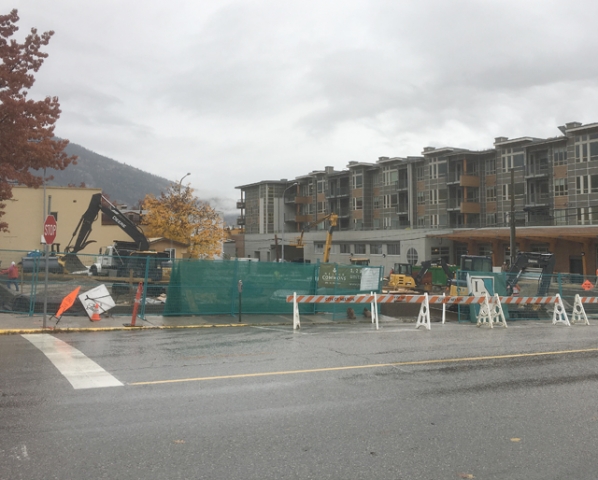A dip in construction figures for 2016 belie a strong building year: development services manager
The prolific building pace of 2015 has slowed in 2016 as major projects in the city are stalled or are nearing completion.
The building numbers in 2016 have not matched what took place in 2015, but city manager of development services Pam Mierau said the inflated numbers of 2015 — with the Nelson Commons and Nelson and District Community Complex renovation projects — have overshadowed what has been another strong year of development for Nelson in 2016.
“The only difference from last year is two very expensive projects. If you take those out of the mix, the number of permits and the construction value of development this year is on par with last year,” she said.
The year of 2015 saw some major movement in the building industry. The total estimated value of new construction, renovation and addition building permits for the year nearly doubled, going from $18.3 million in 2014 to $33.5 million (149 permits to 187) at the conclusion of December.
But in 2016 that pace has slowed, particularly on the estimated value end of the spectrum. The estimated value of the new construction, renovation and addition permits issued in 2016 to date are less than one third of the amount issued in the city last year at $8.9 million.
However, $17.7 million of the permitting in 2015 went to the Nelson and District Community Complex renovation ($4.5 million) and Nelson Commons ($13.2 million).
There have been 16 fewer permits issued so far in 2016 — 121 compared to 137 in 2015 — with the number of dwelling units being built falling from 47 in 2015 to 28 this year.
The biggest projects to get underway this year in Nelson have been phase one of Selkirk College’s interior renovations, valued at approximately $2.75 million, followed by the second 10-plex at Choquette Avenue valued at approximately $1.95 million.
Nelson Landing was expected to be a major player on the development stage in the city this year and it has failed to live up to those aspirations.
The entire waterfront parcel was rezoned in 2015, paving the way for the start of construction on 265 total units of housing, restaurants, senior’s housing, commercial space and small, single-family cottage-type homes on the former Kootenay Forest Products industrial site.
The land had been sitting vacant for a long time because it was contaminated as a former industrial site, but the land is still being remediated for the first eight-plex to be built.
“Development of the eight-plex has not started yet,” said Mierau. “I do not know what the plans are” for construction.
A surprise structure for the downtown and a new owner for the former Kutenai Landing waterfront property were expected to be in store for the real estate and development industry in the city in 2016.
The Kutenai Landing site was sold to Sun Holdings Three Inc. in March of this year, but no movement has taken place on the property. The Houston, Texas-based company is a 25-year-old real-estate investment and management company, with experience in multi-family, hospitality and retail sectors, and with properties located across the globe.
There still could be a development project slated for the downtown announced this year, but the details of which are still considered confidential. Once realized, the new project is expected to add some diversity to the downtown like the nearly complete Nelson Commons will do to the east end of Baker Street.
The Crossing at Granite Pointe in Rosemont was expected as well to have another multi-unit start, after “great sales” on their first 10-plex development two years ago, with a build-out in 2015.
The owners of the Crossing launched another multi-unit start in 2016, said Mierau, with construction on the second 10-plex now underway.
One project that could still come to fruition is Kootenay Christian Fellowship’s affordable housing structure for the same block as Shambhala’s development, but not likely until next year.
Mierau also noted that Selkirk College received $18 million in capital funding for expansion, including the Silver King campus, and construction was expected to begin this year but it has been delayed.
Railtown steams ahead
In Railtown district, land on the north side of Government Road — once deemed contaminated due to previous bulk fuel plants and other industry — has now been remediated. The owner has made it known that the land could be developed, said Mierau.
Not far away, four city-owned houses in the Cottonwood Falls area are still slated for demolition as the city is expected to look for a buyer to develop the land.
Development on city-owned lands will not proceed until approval of the Railtown Sustainable Neighbourhood Action Plan, said Mierau.
Earlier this week the city revealed the Railtown Sustainable Neighbourhood Action Plan (SNAP), expected to form the framework for the creation of a mixture of residential, commercial and industrial, with better connections between Railtown and the downtown.
The 28-acre Railtown neighbourhood has been planned based on a 35-year build out, with approximately 140 units anticipated in Railtown over the next 10 years, along with the potential for approximately 25,000 square feet of new commercial space and 11 acres of new light industrial space (city wide).
“Following approval of the plan, the zoning will more than likely require updates to support development anticipated in the plan,” she said.


























